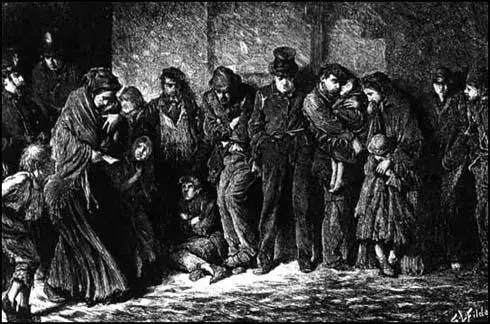The Graphic
The Graphic was founded in December, 1869 by William Luson Thomas, a wood-engraver who believed that illustrations had the power to influence public opinion on political issues. He later recalled: "The originality of the scheme consisted in establishing a weekly illustrated journal open to all artists, whatever their method, instead of confining my staff to draughtsmen on wood as had been hitherto the general custom… it was a bold idea to attempt a new journal at the price of sixpence a copy in the face of the most successful and firmly established paper in the world, costing then only fivepence."
Thomas recruited a team of gifted artists including Luke Fildes, Hubert von Herkomer, Frederick Walker, Frank Holl, Arthur Boyd Houghton, John Millais, Frederic Leighton, Lawrence Alma-Tadema and William Small. When it was first started, the journal was produced in a rented house. However, by 1882 the company owned three buildings, twenty printing machines and employed over 1,000 people. The Christmas edition, printed in colour and costing a shilling, was particularly popular, selling over 500,000 copies in Britain and the USA.
William Luson Thomas was fully committed to social reform and he hoped that these visual images would have a political impact on the reading public. His biographer, Mark Bills, has argued: "The format of the paper offered artists an unprecedented opportunity to explore social subjects, and its images of poverty made it a catalyst for the development of social realism in British art. Many of the wood-engravings which it featured were developed into major paintings." This included Luke Fildes's Houseless and Hungry, which appeared in the first edition of The Graphic.

Hubert von Herkomer wrote: "Mr. Thomas opened its pages to every phase of the story of our life; he led the rising artist into drawing subjects that might never have otherwise arrested his attention; he only asked that they should be subjects of universal interest and of artistic value. I owe to Mr. Thomas everything in my early art career. Whether it was to do a twopenny lodging-house for women in St. Giles', a scene in Petticoat Lane, Sunday morning, the flogging of a criminal in Newgate Prison, an entertainment given to Italian organ grinders, it mattered little. It was a lesson in life, and a lesson in art. I am only one of many who received these lessons at the hands of Mr. W. L. Thomas."
England's leading newspaper, The Times, argued that "William Luson Thomas did more … than improve illustrated journalism, he influenced English art, and that in a wholesome way." Another newspaper described him as "Fair-bearded till time and hard work silvered his hair… Mr. Thomas was a true gentleman - one, indeed, of Nature's noblemen."
In 1889 Thomas and his company, H. R. Baines and Co, began publishing the first daily illustrated newspaper, the Daily Graphic. After William Luson Thomas died in 1900, his son, Carmichael Thomas, ran the company.
Artists employed on the Graphic and Daily Graphic at the end of the 19th century and the early part of the 20th century included Sidney Sime, Alexander Boyd, Frank Brangwyn, Edmund Sullivan, Phil May, Leonard Raven-Hill, George Stampa, James H. Dowd, Bert Thomas and F. H. Townsend.
Primary Sources
(1) The Graphic, Special Christmas Edition (December, 1882)
Only ten years ago, if an event suitable for pictorial illustration occurred on that Saturday, it was considered sharp work to sketch, draw on wood, engrave, electrotype, and print the subject to be illustrated for the issue of the following Saturday. By improved machinery it has become possible to illustrate an event happening on the Tuesday of the same week, and now we propose, by the aid of the new electro-dynamo machines, to save many hours in electrotyping, and so be able to give our latest news pictures up to Wednesday.
(2) On the death of William Luson Thomas, one of his illustrators, Hubert von Herkomer, wrote an account of the importance of The Graphic to social realist artists.
It is not too much to say that there was a visible change in the selection of subjects by painters in England after the advent of The Graphic. Mr. Thomas opened its pages to every phase of the story of our life; he led the rising artist into drawing subjects that might never have otherwise arrested his attention; he only asked that they should be subjects of universal interest and of artistic value. I owe to Mr. Thomas everything in my early art career. Whether it was to do a twopenny lodging-house for women in St. Giles', a scene in Petticoat Lane, Sunday morning, the flogging of a criminal in Newgate Prison, an entertainment given to Italian organ grinders, it mattered little. It was a lesson in life, and a lesson in art. I am only one of many who received these lessons at the hands of Mr. W. L. Thomas.
